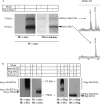The activity of hyaluronan synthase 2 is regulated by dimerization and ubiquitination
- PMID: 20507985
- PMCID: PMC2911313
- DOI: 10.1074/jbc.M110.127050
The activity of hyaluronan synthase 2 is regulated by dimerization and ubiquitination
Abstract
Hyaluronan is a component of the extracellular matrix, which affects tissue homeostasis. In this study, we investigated the regulatory mechanisms of one of the hyaluronan-synthesizing enzymes, HAS2. Ectopic expression of Flag- and 6myc-HAS2 in COS-1 cells followed by immunoprecipitation and immunoblotting revealed homodimers; after co-transfection with Flag-HAS3, also heterodimers were seen. Furthermore, the expressed HAS2 was ubiquitinated. We identified one acceptor site for ubiquitin on lysine residue 190. Mutation of this residue led to inactivation of the enzymatic activity of HAS2. Interestingly, K190R-mutated HAS2 formed dimers with wt HAS2 and quenched the activity of wt HAS2, thus demonstrating a functional role of the dimeric configuration.
Figures







Similar articles
-
Fluorescence resonance energy transfer (FRET) and proximity ligation assays reveal functionally relevant homo- and heteromeric complexes among hyaluronan synthases HAS1, HAS2, and HAS3.J Biol Chem. 2015 May 1;290(18):11479-90. doi: 10.1074/jbc.M115.640581. Epub 2015 Mar 20. J Biol Chem. 2015. PMID: 25795779 Free PMC article.
-
Effects of mutations in the post-translational modification sites on the trafficking of hyaluronan synthase 2 (HAS2).Matrix Biol. 2019 Jul;80:85-103. doi: 10.1016/j.matbio.2018.10.004. Epub 2018 Oct 27. Matrix Biol. 2019. PMID: 30394292
-
Hyaluronan synthase 1 (HAS1) requires higher cellular UDP-GlcNAc concentration than HAS2 and HAS3.J Biol Chem. 2013 Feb 22;288(8):5973-83. doi: 10.1074/jbc.M112.443879. Epub 2013 Jan 9. J Biol Chem. 2013. PMID: 23303191 Free PMC article.
-
Investigation of hyaluronan function in the mouse through targeted mutagenesis.Glycoconj J. 2002 May-Jun;19(4-5):341-5. doi: 10.1023/A:1025321105691. Glycoconj J. 2002. PMID: 12975614 Review.
-
Hyaluronan: a critical regulator of endothelial-to-mesenchymal transition during cardiac valve formation.Trends Cardiovasc Med. 2013 Jul;23(5):135-42. doi: 10.1016/j.tcm.2012.10.002. Epub 2013 Jan 5. Trends Cardiovasc Med. 2013. PMID: 23295082 Review.
Cited by
-
Collagen VI and hyaluronan: the common role in breast cancer.Biomed Res Int. 2014;2014:606458. doi: 10.1155/2014/606458. Epub 2014 Jul 14. Biomed Res Int. 2014. PMID: 25126569 Free PMC article. Review.
-
A functional outside-in signaling network of proteoglycans and matrix molecules regulating autophagy.Matrix Biol. 2021 Jun;100-101:118-149. doi: 10.1016/j.matbio.2021.04.001. Epub 2021 Apr 7. Matrix Biol. 2021. PMID: 33838253 Free PMC article.
-
Hyaluronic acid metabolism and chemotherapy resistance: recent advances and therapeutic potential.Mol Oncol. 2024 Sep;18(9):2087-2106. doi: 10.1002/1878-0261.13551. Epub 2024 Mar 21. Mol Oncol. 2024. PMID: 37953485 Free PMC article. Review.
-
CRISPR/Cas9 knockout of HAS2 in rat chondrosarcoma chondrocytes demonstrates the requirement of hyaluronan for aggrecan retention.Matrix Biol. 2016 Dec;56:74-94. doi: 10.1016/j.matbio.2016.04.002. Epub 2016 Apr 14. Matrix Biol. 2016. PMID: 27094859 Free PMC article.
-
Chain gangs: new aspects of hyaluronan metabolism.Biochem Res Int. 2012;2012:893947. doi: 10.1155/2012/893947. Epub 2011 Dec 18. Biochem Res Int. 2012. PMID: 22216413 Free PMC article.
References
Publication types
MeSH terms
Substances
LinkOut - more resources
Full Text Sources
Molecular Biology Databases

